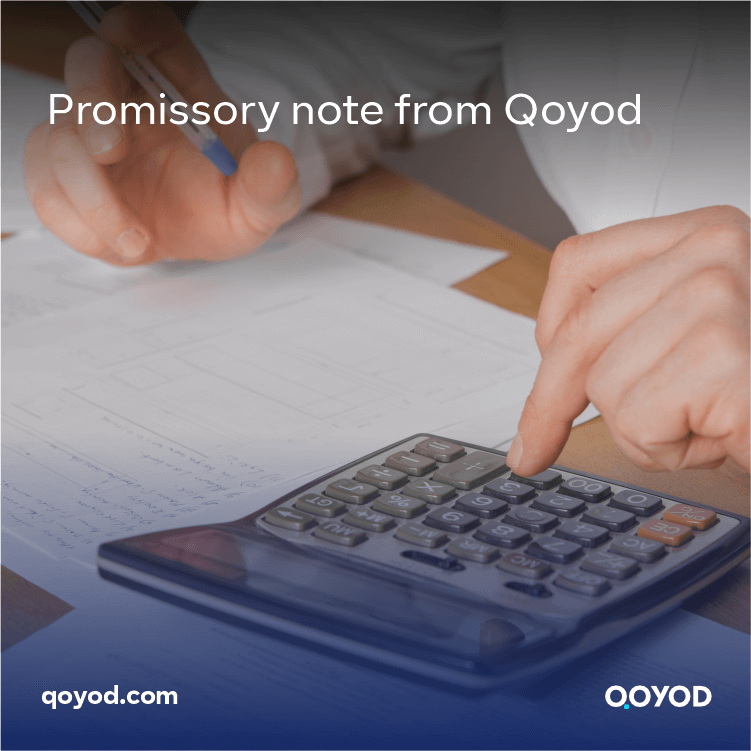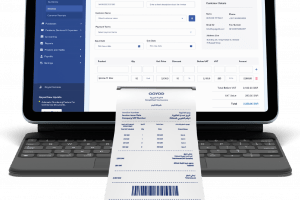In the world of accounting, a promissory note is a powerful tool that plays a vital role in regulating financial relationships and enhancing trust between transacting parties. It is like words written on a piece of paper that carry a binding promise to pay a specific amount of money at a specific date in the future, and its uses in accounting are numerous. It may be issued as a tool for financing, settling debts, or organizing commercial contracts, but have you ever wondered about the true power of this small piece of paper? Have you thought about whether it is just a document or has special powers that affect the financial and economic world? If you want to explore deeper into the world of this bond and uncover the secrets it holds, then you are in the right place, so follow this article with us.
What is the definition of a promissory note?
It is a financial instrument that includes a written and signed promise to pay a specific amount of money to the holder of the bond in exchange for obtaining a loan or other financing. It usually contains a set of main points that include the terms of the debt, details regarding the amount owed, the repayment schedule, as well as the signature of the issuer and the date and place of issuance.
The promissory note is an important document because it specifies the rights and obligations of the parties involved in the financial transaction, and through it, the issuer, or the maker of the bond, undertakes to pay the specified amount to the owner of the bond, whether upon request or at a specific future date.
In addition, the promissory note contains important information, such as the original amount due and its due date. Thus, this helps in determining the payment schedule and the financial obligations associated with it. This promissory note also includes the issuer’s signature as evidence of his commitment to pay.
What are the terms of a promissory note?
It is a document used in commercial transactions to issue a financial order from one person to another. In order for a promissory note to be valid and legally binding, it must meet some basic conditions that prove its validity, which are as follows:
Condition of the note
The order must be clearly stated in the bond and express the commitment to pay a specific amount of money. The amount of money and the expected date of payment must be specified.
language of the promissory note
The promissory note must be written in the same language used in the main text of the instrument. If the promissory note is in Arabic, the promissory note must be written in Arabic.
Suspension of terms
The promise to pay must be unconditional; in other words, the obligation to pay must be independent of any additional conditions. If a comment or condition is added that restricts the obligation to pay, this makes the instrument invalid as a commercial order.
due date
The due date of the promised amount must be mentioned, and it expresses the date on which the financial amount must be paid. If the due date is not mentioned, the amount is due immediately upon viewing the bond.
Place of payment
The city and country must be mentioned, as payment must be made, and if the place of payment is not mentioned, the place where the bond was issued is considered the place of payment.
Name of the payee
The name of the person to whom the amount is to be paid must be mentioned in the promissory note, who is called the payee or creditor.
Date and place of issue
The date of issuance of the bond and the city in which it was issued must be mentioned. If the place of issuance is not mentioned, the place of issuance is the city mentioned next to the name of the issuer.
Debtor’s signature
The promissory note must be signed by the debtor, who is the person who bears financial responsibility for the payee. The signature can be electronic, and according to Article Five of the Electronic Transactions Law, electronic signatures are valid and legally binding.
Notice
Pursuant to the requirements for a promissory note, the Ministry of Justice has launched a platform called “Nafith,” which enables individuals and companies to issue and create promissory notes that meet all the conditions and elements mentioned, have the bonds signed by the debtor, and be approved as an executive document linked directly to the enforcement courts. It is worth noting that this platform enhances confidence in the validity and completeness of the data included on the bond and is compatible with the commercial paper system.
What is the difference between a promissory note and a bill of exchange?
If you are wondering, what is the difference between a bill of exchange and a promissory note? Follow this table:
| The differences | Promissory note | Bill of exchange |
| Legal nature | It is a type of payment order issued by the issuer in favor of the payee. | It is a written promise to pay a specified amount at a future date. |
| Participating parties | It includes two main parties: the issuer (who issues the bond) and the payee (who will receive the amount). | It includes three parties: the drawer (who issues the order to pay), the drawee (who will make the payment), and the payee (who will receive the amount). |
| the use | It is mainly used to determine the obligation to pay. | It is used to determine the obligation to pay and trade as a security. |
| payment method | Includes an explicit directive to pay to the payee. | They include an order to pay to the drawer and can be traded or sold. |
| Legal structure | It is a transferable financial instrument. | It can be traded in accordance with financial and commercial laws. |
What is the difference between a promissory note and a Cheque?
If you’re wondering what the difference is between a check and a promissory note, follow the following:
promissory note
- It is a document that contains a commitment to pay a sum of money on a specific date.
- A promissory note is usually issued by the seller to the buyer as confirmation of the payment obligation.
- Any promissory note involves two main parties: the issuer (the sender) and the payee.
- The amount specified in this type of bond is paid upon receipt according to the arrangements specified in the document.
- It is commonly used in commercial and international business transactions.
Cheque
- It is a payment method that contains a financial directive from the holder (bank account holder) to the bank to pay a specific amount to the payee.
- A check involves three main parties: the account holder (sender or drawer), the bank, and the payee.
- The amount specified on the check is paid from the drawer’s account at the bank when presented by the payee.
- A check is used for direct account-to-account payments.
What is the benefit of a promissory note?
There are many advantages to promissory notes that make them useful and effective in various fields, and the most important of these advantages are the following:
- Ease of transfer of ownership: A promissory note allows the transfer of ownership of funds easily and efficiently between trading parties, as it can be traded between individuals and companies.
- Facilitating financial transactions: This bond is an effective means of facilitating financial transactions and settling obligations, whether in daily or large commercial transactions.
- Payment Guarantee: A promissory note represents a binding undertaking by the debtor to pay the beneficiary on the specified date, which provides security to the beneficiary party.
- Binding legal form: A promissory note is a binding legal obligation that strengthens the obligation to pay and regulates the financial relationship between the parties.
- Documenting the financial obligation: A bond documents a specific financial obligation, making it an official document committing to pay, specifying the amount, and timing.
- Ease of transfer: The bond can be easily transferred from one person to another, making it negotiable and transferable quickly.
- Saving time and effort: It contributes to saving time in financial transactions, as it is sufficient for the issuer to issue it and the beneficiary to collect payment when due.
An example of a promissory note
Suppose (X) loans SAR 40,000 to his friend Y to help him cover unexpected medical expenses. To ensure clarity and confidence in their understanding, they create a promissory note. The note states that Y agrees to repay the loan within six months, applying an interest rate of 5%, and also describes a monthly repayment schedule. It is worth noting that by signing the promissory note, both parties have a documented agreement that provides a sense of security and transparency. This ensures that their friendship remains intact while fulfilling their financial responsibilities.
Examples of the importance of a promissory note
Suppose (X) lent his friend Y the amount of SAR 10,000 without using the promissory note template, and they agreed on a repayment plan, but unfortunately Y ran into financial difficulties and was unable to make the agreed payments. Without a promissory note, X had difficulty enforcing the loan agreement and getting his money back.
On the other hand, (S) also loaned her friend (Y) the amount of 10,000 Saudi riyals, but she used the promissory note that was formulated correctly, as the form clearly states the terms of the loan, including the repayment schedule, the consequences of defaulting on it, and when (Y) fails to make payments as agreed, S was able to take legal action based on the promissory note and eventually got her money back through a court ruling.
Download a promissory note form.
Download a promissory note form from here, valid promissory note forms with and without exemption.
How to manage customer receipts via the Qoyod website
You can easily add a new customer receipt to Qoyod and manage all your customer receipts by following these steps:
Access the Customer Receipts page.
From the Sales drop-down menu, you can access the “Customer Receipts” page by clicking on it. It is worth noting that this page will show you all customer receipts registered in the system.
Create a new customer receipt.
At the top of the “Customer Receipts” page, you will find the “Create Customer Receipt” option. By clicking on it, the form to create a promissory note for a new customer will open.
Fill in the new receipt data.
In the new receipt . creation form, you will need to fill in the following data:
- Reference Number: A serial number will appear automatically, which you can change if you wish.
- Contact Name: Choose the customer’s name from the drop-down list.
- Account: Select or add the bank or cash account from which it will be received.
- Receipt Type: Choose a type, whether it is a promissory note or any other type.
- Description: Add a short description for the receipt.
- Date: Specify the date the recipient was created.
- Amount: Enter the amount to be added or subtracted.
- Allocate Receipt: If the receipt is to pay a previous invoice, mark the appropriate box and choose the invoice from the list.
Save the new receipt.
After filling out all the required data, click on the “Save” button to create the new receipt.
filtering and export of receipts
On the receipt management page, you can filter the receipts according to the available options (all receipts, supplier receipts, customer receipts, receivable receipts, and exchange receipts), and you can also export the receipts to an Excel file for further analysis and processing.
Conclusion
Procurement remains a basic rule in modern accounting. It is an effective tool for documenting financial operations and enhancing transparency and credibility in business. Thanks to it, companies and institutions can track and document every financial transaction accurately and professionally. Moreover, this document is a powerful tool for financial oversight and internal control. It enables organizations to achieve effective control over their financial activities and monitor illegal or unauthorized operations. In addition, it contributes to facilitating financial auditing and review operations, as auditors can rely on proven documents to verify the validity and suitability of financial operations. Despite the development of technology and the emergence of electronic payment methods, the order document remains of great importance as it provides paper and official evidence that can be relied upon in the event of financial disagreements or disputes.
It is clear that the promissory note is a crucial tool in the world of accounting, and companies and institutions should take full advantage of it. This can only be done by using an accounting program that saves time, such as the Qoyod program. It is worth noting that the program also offers all its clients various electronic invoice systems and a point-of-sale system to meet what individuals need in the world of accounting.
After you know what promissory notes are, try Qoyod now for free for 14 days and enjoy saving your time and money. It is an affordable, certified accounting program.
Join our inspiring community! Subscribe to our LinkedIn page and Twitter to be the first to know about the latest articles and updates. An opportunity for learning and development in the world of accounting and finance. Don’t miss out, join us today!




